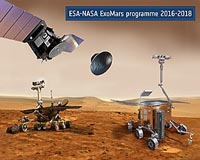 |
Greenbelt MD (SPX) Jan 06, 2010 The quest to discover whether Mars ever hosted an environment friendly to microscopic forms of life has just gotten a shot in the arm. "Mars was a lot different 3-1/2 billion years ago. It was more like Earth with liquid water," said Jennifer Eigenbrode, a scientist at the NASA Goddard Space Flight Center in Greenbelt, Md. "Maybe life existed back then. Maybe it has persisted, which is possible given the fact that we've found life in every extreme environment here on Earth. If life existed on Mars, maybe it adapted very much like life adapted here." An experiment proposed by Eigenbrode has been added to the Sample Analysis at Mars (SAM) instrument on a mobile NASA laboratory that will land on Mars in 2012. Goddard scientists developed SAM. The newly added experiment will enhance SAM's ability to analyze large carbon molecules if the mission is fortunate enough to find any. The mission, NASA's Mars Science Laboratory, will be checking whether a carefully chosen area of Mars has ever had an environment favorable for the development of life and preservation of evidence about life. The mission's car-sized rover will analyze dozens of samples scooped from soil and drilled from rocks. None of the rover's 10 instruments is designed to identify past or present life, but SAM has a key role of checking for carbon-containing compounds that potentially can be ingredients or markers of life. Most environments on Mars may not have enabled preservation of these compounds, which are called organic molecules, but if any did, that could be evidence of conditions favorable for life. Eigenbrode secured the flight opportunity for her experiment after successfully proving in a series of tests earlier this year that the combination of heat and a specific chemical would significantly enhance SAM's ability to analyze large carbon molecules. In particular, Eigenbrode's experiment will provide far more details about the evolution of large organic molecules that are made up of smaller molecules such as carbohydrates, lipids, proteins, and nucleic acids - should SAM find them. "Our experiment preserves information on how these molecules formed," she said. "What we'll get are key observations that tell us about organic carbon sources and processing on Mars - shedding light on the planet's carbon cycle."
Complex Instrument As planned, the rover's robotic arm will scoop up the soil and drill rock samples and a separate mechanism will deliver the samples to SAM's sample-manipulation system, a carousel-like device that contains two concentric rings holding 74 tiny tubes. Once the tubes are filled with the fine-grained samples, the carousel will rotate and insert the tube inside a pyrolysis oven. As the oven heats, the hermetically sealed sample will begin to break down, releasing gases that SAM's instrument will then analyze for potential biomarkers. There is a catch, however. Although SAM will be effective at identifying organic compounds, heat breaks carbon bonds, resulting in fragmentation and the loss of molecular information. What was needed, Eigenbrode believed, were other ways to prep the samples to prevent fragmentation and obtain more details. In her quest to find these techniques, Eigenbrode investigated methods that would give a robotic laboratory operating millions of miles from home the same flexibility and capability of an Earth-based organic geochemistry laboratory. "Sample preparation is the forgotten science in Mars exploration," Eigenbrode said. "An instrument is only as good as the sample, and there is no single method for identifying all molecular components." In 2009, she tested rocks similar to those found on the red plant, prepping the sample with a small amount of tetramethylammonium hydroxide in methanol (TMAH), a chemical mixture used in laboratories for studying organic compounds. She then heated the sample to determine whether the TMAH not only preserved the sample's molecular structure, but also could survive the higher levels of radiation found on Mars. The testing proved successful.
No Technology Hurdles Seeing the benefit of adding Eigenbrode's sample-preparation method to the overall SAM mission, Principal Investigator Paul Mahaffy and scientists Daniel Glavin and Jason Dworkin agreed to donate two of the 10 cups for her experiment. Just a few weeks ago, the SAM team added and sealed the TMAH chemical inside the two cups. "With the addition of Jennifer's chemical toolkit, the range of organic molecules that SAM can detect has been expanded with no hardware modifications. It provides a promising path to contribute to our understanding of the biological potential on MARS," Mahaffy said. "When I began working on my concept in early 2009, I thought it might be suitable for a future Mars mission, perhaps in 2016," Eigenbrode said. "I never thought that it would fly so soon on SAM. I believe we have really enhanced the capabilities of SAM should it find organic material. What I really want now is to find macromolecules on Mars."
Share This Article With Planet Earth
Related Links - Mars News and Information at MarsDaily.com Lunar Dreams and more
 ESA Member States Give Green Light To ExoMars Programme
ESA Member States Give Green Light To ExoMars ProgrammeParis, France (ESA) Dec 21, 2009 ESA's Council yesterday gave the go-ahead to proceed with the implementation of the ExoMars Programme. This decision paves the way for two Mars exploration missions in cooperation with NASA in 2016 and 2018. The ExoMars Programme aims to investigate the martian environment, particularly astrobiological issues and to develop and demonstrate new technologies for planetary exploration with ... read more |
|
| The content herein, unless otherwise known to be public domain, are Copyright 1995-2009 - SpaceDaily. AFP and UPI Wire Stories are copyright Agence France-Presse and United Press International. ESA Portal Reports are copyright European Space Agency. All NASA sourced material is public domain. Additional copyrights may apply in whole or part to other bona fide parties. Advertising does not imply endorsement,agreement or approval of any opinions, statements or information provided by SpaceDaily on any Web page published or hosted by SpaceDaily. Privacy Statement |